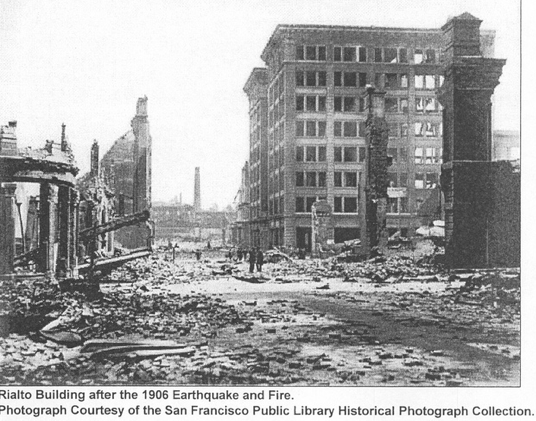116 New Montgomery
South of Market
I became intrigued with this building when a friend showed me this Black and White photo in the lobby of the Rialto.
(Note: the round building on the left is the Crossley building)
The Rialto is an eight-story H-shaped plan with center light courts. It has a steel frame clad in brick and terra cotta. The eighth story is highly ornamented. The façade accommodated the lack of interior partition walls by providing a large space between the window mullions. This allowed partitions to be erected between the windows once floors were leased. Since the interior lacked dividing partition walls, tenants could rent large floor areas that could be configured according to their needs.
 Originally constructed in 1902, it was reconstructed in 1910 after the 1906 Earthquake and Fire. The original 1902 building façade was maintained. The 1910 reconstruction consisted primarily of structural improvements.
Originally constructed in 1902, it was reconstructed in 1910 after the 1906 Earthquake and Fire. The original 1902 building façade was maintained. The 1910 reconstruction consisted primarily of structural improvements.
In 1902, during the 20th century building boom, Herbert Law financed construction of the Rialto Building, as well as the Crossley Building. The Rialto was named after a commercial center in Venice, Italy, a rialto is an exchange or mart.
Law hired the architectural firm of Meyer & O’Brien. Meyer & O’Brien, who despite only operating between 1902 and 1908, were prolific in the Financial District, designing some of San Francisco’s most prominent buildings, including the Monadnock Building, 637-687 Market Street (1906); the Humboldt Bank Building, 793- 785 Market Street (1906); the Hastings Building, 180 Post Street (1908); the Foxcroft Building, 68-82 Post Street (1908); and the Cadillac Hotel, 380 Eddy Street (1909).
 Terra Cotta work by Steiger Terra Cotta and Pottery Works
Terra Cotta work by Steiger Terra Cotta and Pottery Works
After the 1906 Fire and Earthquake Bliss & Faville was hired to supervise the reconstruction of the Rialto Building, as Meyer & O’Brien were no longer architectural partners and Bliss & Faville had gained prominence. Bliss & Faville was among the most established architectural firms in San Francisco during the reconstruction period after the Earthquake and Fire.
******
In June 1910, the San Francisco Call newspaper ran this article:
“The reconstruction of the old Rialto building at the corner of Mission and New Montgomery streets has begun. Dr. Hartland Law, the owner, is preparing to spend about $500,000 in rebuilding it on a handsomer plan than the original structure. The old building was erected in 1901 at a cost of $650,000.
The great fire left it a complete wreck. The walls have stood, but the steel frame was so bent and twisted most of it has had to be taken out. New steel columns have been put in from basement to roof. All the steel is being fireproofed with cement this time, instead of with terra cotta, as previously. The fireproof flooring is already in on the two upper stories. All the reconstruction work will be of class A quality throughout. The outer brick work will be cleaned and treated in some way to brighten it up and make it look like an entirely new building. The corridors will be wainscoted with marble and will have a flooring of mosaic tiling. They will be wider and brighter than in the old building. The woodwork of the building will be of oak. Metal doors probably will be put in. Special attention is being paid to the plumbing equipment. There will be a vacuum cleaning system and compressed air supplied to all the offices. There will be four high speed elevators, the contract for putting them in having already been let. The light, heat and power for the building will be supplied from a plant being constructed on a lot adjoining the main building. A special feature will be equipment for sterilizing water for drinking purposes. After the heating process it will be cooled and distributed to every suite in the building by faucets. In this and other ways Doctor Low [sic] has studiously endeavored to make the new building thoroughly modern and up to date in every particular. McDonald & Kahn have general engineering charge of the whole reconstruction work and are letting all the contracts. Bliss & Faville are the architects.”
When the work on the Rialto Building was complete, the project was lauded as the building that restored faith in the City. The Rialto Building had been the feature of numerous newspaper articles during the reconstruction period because of its location and because the building shell had remained intact and highly visible.




